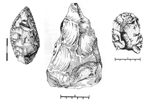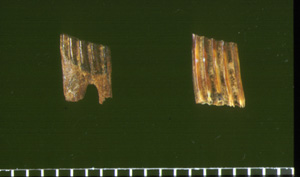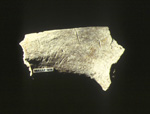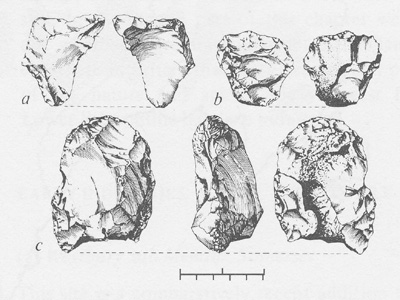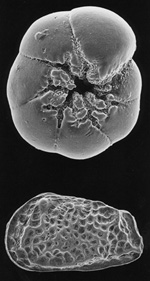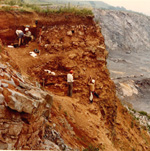
The
AHOB Picture Library
Preglacial
|
Pre-Anglian
artefacts from High Lodge (left), Kents Cavern (middle), and Westbury-sub-Mendip
(right).
|
Lateral
views of cheek teeth of the vole Mimomys (left) and its
descendant, Arvicola (right). Teeth of the former cease
growth after eruption and develop roots; those of the latter continue
to grow throughout the life of the animal and so lack roots. Evolutionary
changes in the Mimomys / Arvicola lineage have been used
to date the earliest occurrence of hominids in Europe.
|
||
|
Handaxe
and cutmarked bone from Boxgrove, West Sussex. A typical example
of a well-made limande/ovate biface from Pre-Anglian landsurface
associated with the Goodwood-Slindon Raised Beach. Microwear analysis
of unpatinated handaxes from the site shows that they were used
to butcher large mammals.
|
Mole
humeri from Westbury-sub-Mendip. Common mole Talpa europaea (left),
and the small extinct mole T. minor (right).
|
||
|
Boxgrove
cutmarks
|
Artefacts
from the Calcareous Member, Westbury-sub-Mendip described by Bishop.
|
||
|
Foraminifer:
Ammonia falsobeccarii (Rouvillois), umbilical view, x 295
(top).
Ostracod: Baffinicythere howei Hazel, female left valve, x 90 (bottom). |
Natural
History Museum excavation at Westbury-sub-Mendip cave. The infilled
cavern sediments were exposed by limestone quarrying in the late
1960s.
|
||
|
Scrapers
from the clayey silts at High Lodge.
|
Westbury-sub-Mendip
opening
|
||
|
Handaxes
from Kent's Cavern from basal breccia underlying a stalagmite
floor dated to >350,000 years ago.
|
Small
mammal remains are often found in great abundance as this example
of a barn owl accumulation from Westbury Cave illustrates. Small
mammals are sensitive indicators of environment and environmental
change, and provide important taphonomic and biostratigraphical
information.
|
All images on this site are in copyright and unauthorized reproduction is strictly forbidden.
Images may be printed out or downloaded from this site for personal
reference only, provided they are not subsequently copied, published,
scanned, photographed, broadcast or reproduced in any way whatsoever.

